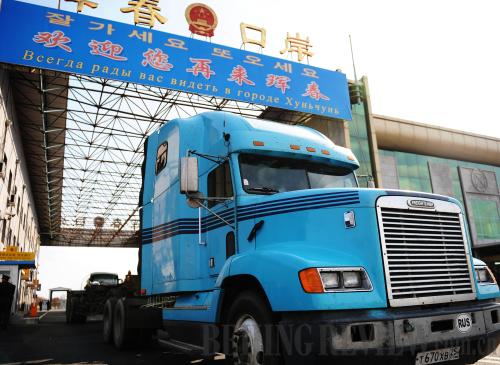 |
|
PORT CITY: A Russian truck enters China through Hunchun Port in Jilin Province. Hunchun, a city bordering North Korea and Russia, plans to establish itself as the gateway to northeast Asia (XU JIAJUN) |
While growing intra-regional trade has sparked optimism about the potential success of regional economic cooperation, the reality is that China, Japan and South Korea are far more reliant on the U.S. and EU markets than on each other.
"Last year intra-regional trade between the region's four major economies (including Russia) accounted for less than 20 percent of northeast Asia's total foreign trade," according to Qu Wei, Director of Heilongjiang Academy of Social Sciences. In the EU and North American FTA intra-regional trade stands at about 70 percent and 40 percent, respectively.
"Economic growth in northeast Asia has been highly dependent on extra-regional trade," said Fu Jingjun, a researcher with the Institute of Asia-Pacific Studies of CASS.
"Most of the products traded between China, Japan and South Korea were intermediate products rather than final ones and those intermediate products were finally exported to the United States after being processed and assembled in China," he said.
"In this sense, the three countries won't limit their economic cooperation mechanism to the region, but will always look beyond their immediate neighborhood," said Fu.
Given the relatively low volume of intra-regional trade, the benefits of an FTA remain unclear. Meanwhile, different economic development levels of the region's countries and political considerations add to uncertainties about the viability of an FTA.
"As a result of its colonization of China and North Korea last century, Japan is not active in establishing a northeast Asian regional economic community," said Koichi Ito, Managing Director of the Economic Research Institute for Northeast Asia based in Niigata, Japan.
"The huge gap in political systems and economic development levels among northeast Asian countries means that the region cannot be a unified market like North American FTA and the EU," said Kim Cheol, Director of the Institute of Economy with the North Korea National Academy of Social Sciences.
The uncertain future of an FTA, however, does not mean that economic links between northeast Asia's major economies won't continue to grow stronger.
"As it takes time to establish an FTA, at present we should actively promote trade and investment outside of an FTA framework, and enhance sub-regional cooperation," said Zhang of the CASS.
"The establishment of a regional economic community requires the free flow of people, goods and capital," said Ito. "But different development levels of Japan, South Korea and China mean that such free movement cannot be established."
"At present Northeast Asian countries can cooperate in fields where they share common interests, such as increasing energy efficiency, the development of new technology, logistics and cultural exchange," said Chae of the South Korea Institute for International Economic Policy.
According to Zhang, improving regional infrastructure should be the key priority for northeast Asia's countries.
"Northeast Asian countries should work together on planning railway, highway, sea routes and air networks, this will propel the growth of regional trade," he said.
In May 2009, the China-Russia-South Korea-Japan joint rail-port transportation route was formally launched in Hunchun of Jilin. With a total length of 800 nautical miles, the whole route can be completed in as little as one and a half days. Located just 15 km from the Sea of Japan, Hunchun lies 850 km west of Niigata.
"Hunchun is half the distance between the more prominent port of Dalian, Liaoning Province, and Japan, allowing companies that utilize the new trade route to save one third of the time, as well as 30-40 percent of the shipping costs," said Deng Kai, an official of the Yanbian Korean Autonomous Prefecture of Jilin.
This May a 20-km-long international railway route from Hunchun to the Russian city of Kamyshovaya was launched.
"The railway will greatly facilitate Sino-Russian trade," said Liu Shuming, a researcher with the Jilin Provincial Development Research Center.
Liu also said that the number of flights between Yanji of Jilin and South Korea has been increasing steadily in recent years. China and Russia have also agreed to begin flights between Yanji and Vladivostok, Russia's largest port city on the Pacific Ocean.
Sub-regional cooperation has also spurred regional development. As early as 1991, the United Nations Development Program encouraged northeast Asian countries to cooperate to develop the Tumen River region.
Starting from the Changbai Mountains of Jilin and flowing through China, North Korea and Russia into the Sea of Japan, the 525-km-long Tumen River is located at the epicenter of Northeast Asia.
In December 1995, the governments of China, North Korea, South Korea, Mongolia and Russia signed the Agreement on the Establishment of the Consultative Commission for the Development of the Tumen River Economic Development Area and Northeast Asia.
On August 30 2009, China's State Council approved the Changchun-Jilin-Tumen Pilot Area for development and opening up.
"The pilot area has upgraded the development of the Tumen River region to a national strategy," said Jiang Zengwei, Vice Minister of Commerce, at the expo. | 